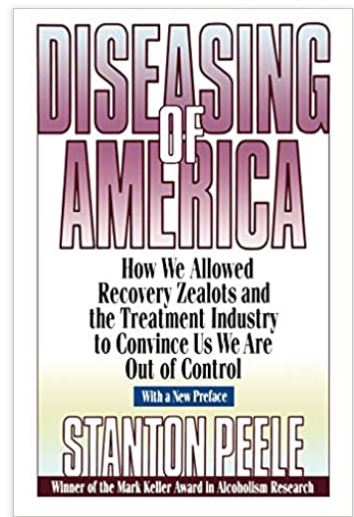When it comes to thinking about addiction, opinions converge. Having bought into the addiction industry’s mantra, so-called social progressives and conservatives alike share the same ideological hangover from the Prohibition era, with a twist of AA sadism: all are religious about abstinence, and all accept as bible from Sinai the wisdom of coercing addicts into treatment regimens. But perhaps the greatest error made in the attempt at humane formulations about addiction is to cast as a disease what is essentially a problem of behavior.
The dangers of gathering more and more behaviors under the disease label is not something pharmacology moguls, politicians or health care professionals ruminate about, despite the ramifications for a society already committed to a morality lite and to diminished personal responsibility. In his book Diseasing of America, addiction researcher Stanton Peele breaks with this tradition. Disease conceptions of misbehavior are bad science and morally and intellectually sloppy, argues Peele. “Once we treat alcoholism and addiction as diseases, we cannot rule out that anything people do but shouldn’t is a disease, from crime to excessive sexuality to procrastination.”
While the application of the medical disease model to addictions was developed to “remove the stigma from these behaviors,” there is no genetic marker for alcoholism or drug addiction. Still, the misconception that these behaviors are linked to a genetic vulnerability is aired repeatedly by the media, in the absence of evidence. The rationale for using the disease model to describe addiction even though it is intellectually dishonest is that medical treatment is effective.
Yet another deception. An overview of controlled studies indicates that “treated patients do not fare better than untreated people with the same problems.” Of note is a 4500-subject-strong 1996 US epidemiological study conducted by the National Longitudinal Alcohol Epidemiological Survey. Treated alcoholics, it was found, were more heavily alcohol dependent on average than untreated alcoholics. Clearly a behavioral problem cannot be remedied by medical intervention. Addicts are cured when they decide to give up the habit.
The disease conception of addiction acts to isolate the noxious behavior from the person. Thus when we claim that drugs, much like the flu, “get a hold” of you, we conveniently deflect from that which mediates behavior: personality, values, character or lack thereof. Once someone becomes involved with drugs, we explain everything they do by saying it was due to the drugs, forgetting, in the process of this circular argument, that the source of the addiction is the person and not the drug. An honest look at drug-use means we cannot separate it from the person.
Heroin addicts are thus highly disposed to having social problems even before they become addicted, and truancy and smoking behavior serve as good predictors of future drug use.
With the disease label as a protective rampart, addicts have taken to comparing their “disease” with having, let’s say, diabetes or cancer. How opting to shoot up for the first time, then doing it again, then stealing to get some, even breaking and entering mimic the organic disease process in cancer or diabetes is unclear.
As Peele explains, addictive disorders are known only by the behaviors they describe. In the absence of the ongoing behavior there is no way of telling whether the person is, or will be addicted. “By claiming that alcoholics are alcoholics even if they haven’t drunk for fifteen years, alcoholism is made to seem less tied to drinking behavior and more like cancer.” But “a person does not get over cancer by stopping a … behavior”…while “the sole and essential indicator of successful remission of alcoholism is that a person ceases to drink.”
It is unfortunate that the various preventive programs school kids are exposed to are delivered by equivocating addicts-cum-activists who conveniently convey that “It” can happen to anyone, that kids have little control and that once diagnosed as an addict, always an addict. This sets in motion–where there is already some drug use–a self-defeating cycle of abstinence and relapse, not to mention an overall rise in drug related involvement.
Most youngsters outgrow their occasional binges and turn into responsible adults. For doing what they do as a rite of passage, teens and college students do not deserve to be labeled diseased. What they do need is to be held accountable for their behavior. Failure to hold the person who strays responsible for his actions means that you cannot credit the person who doesn’t stray. That’s the logic of diminished responsibilities all round.
For the rest, the lingering paranoia of the temperance and prohibition era, which has culminated in AA disease dogma, should be consigned to the historical dustbin.
©2000 by Ilana Mercer
The Calgary Herald
June 22
CATEGORIES: Drug War, Junk Science, Logic & Reason, Pseudoscience, Psychiatry & The Therapeutic State, Therapeutic State

 print
print